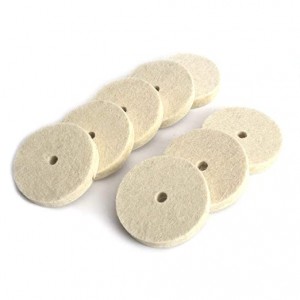In an era dominated by mass – produced goods, there is a growing movement to revive traditional crafts, and wool felt wheels are playing an unexpected yet crucial role in this renaissance. These humble tools, originally developed for industrial applications, are now being embraced by artisans and craftspeople to breathe new life into age – old techniques and create unique, handcrafted works of art.
In the world of pottery, wool felt wheels are being used to achieve a level of finish that was previously difficult to attain. Potters often strive for a smooth, polished surface on their ceramic pieces, and wool felt wheels offer a gentle and effective solution. After shaping and firing, the potter can use a wool felt wheel, along with a suitable polishing compound, to buff the surface of the pottery. This not only removes any minor imperfections but also brings out the natural luster of the clay, enhancing the overall aesthetic appeal of the piece. The soft fibers of the wool felt wheel ensure that the delicate surface of the pottery is not damaged during the polishing process, allowing the potter to achieve a professional – looking finish without the risk of scratching or chipping.
Similarly, in the craft of woodturning, wool felt wheels have become a favorite tool among turners. When creating wooden bowls, vases, or other turned objects, achieving a smooth and even surface is essential. Wool felt wheels can be used to sand and polish the wood, creating a luxurious, satin – like finish. Turners can vary the pressure and speed of the wool felt wheel to achieve different textures and effects, from a high – gloss shine to a more muted, matte finish. This versatility allows them to express their creativity and add a personal touch to their handmade wooden items.
The revival of traditional textile crafts also benefits from the use of wool felt wheels. In rug making and tapestry weaving, for example, wool felt wheels can be used to finish the edges of the textiles, giving them a neat and professional appearance. Additionally, some textile artists are using wool felt wheels to create unique textures and patterns on their fabrics. By rubbing the wool felt wheel over the surface of the fabric in a specific way, they can create raised or textured areas, adding depth and dimension to their textile artworks.
The use of wool felt wheels in traditional crafts not only helps to preserve these age – old techniques but also attracts a new generation of artisans. Younger craftspeople are drawn to the combination of traditional craftsmanship and modern tools, seeing the potential to create innovative and contemporary works while still respecting the heritage of the craft. As the movement to revive traditional crafts continues to gain momentum, wool felt wheels will likely play an even more significant role, bridging the gap between the past and the present and inspiring a new wave of creativity in the world of handmade goods.

Post time: Jun-06-2025
